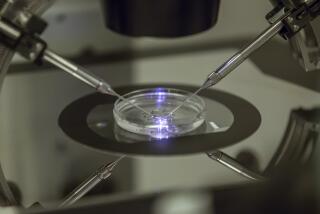Parkinson’s Victim Given Brain Tissue From Fetus
- Share via
Medical researchers have transplanted brain tissue taken from a spontaneously aborted fetus into the brain of a man with Parkinson’s disease--the first reported human brain-to-brain transplant.
In another operation the same day, Mexico City neurosurgeon Dr. Ignacio Navarro Madrazo, a pioneer in experimental therapies for Parkinson’s disease, also grafted pieces of the same fetus’s adrenal glands into the brain of a woman with Parkinson’s--the first time fetal adrenal tissue has been used for that purpose.
Within two weeks of the Sept. 12 operations, both patients experienced significant reductions in the amount of trembling and rigidity caused by the disease, and regained their ability to write, dress themselves and walk easily, Madrazo said in a letter in today’s New England Journal of Medicine. The operations were performed at La Raza Medical Center in Mexico City.
In previous experimental surgeries, in Mexico and elsewhere around the world, in which Parkinson’s patients have received their own adrenal tissues, many also showed dramatic initial improvements, which later leveled off.
Researchers are excited about the potential of such fetal cell therapy because animal studies have shown that fetal tissues are much more effective at relieving Parkinson’s symptoms than adult cells that have so far been used in human experiments.
Furthermore, many believe that use of fetal tissues could open the door to treatment of other degenerative brain diseases, including Alzheimer’s and Huntington’s diseases.
“It’s really an exciting thing,” said USC neurosurgeon Michael Apuzzo. “We’re going to see a lot more major changes like this in neurosurgery.”
Madrazo’s approach raises many ethical questions about the propriety of using tissues from an aborted fetus to treat humans. In particular, medical ethicists have raised the specter of women conceiving a fetus for the sole purpose of aborting it and then harvesting its organs either to treat a diseased relative or to sell. “It’s really a thorny ethical problem,” said ethicist Arthur Caplan of the Center for Biomedical Ethics at the University of Minnesota.
The use of fetal cells in laboratory research is not new. In the United States, cells taken from spontaneously aborted fetuses often are made available to researchers by the National Disease Research Interchange, a clearinghouse set up by the National Institutes of Health.
There is “very little resistance” to the idea of using such fetuses for experimental therapy or research--as long as they are no longer alive, said pediatrician and ethicist Kathy Nolan of the Hastings Center in Briarcliff Manor, N.Y..
But the practice of actually using fetal cells to treat human patients is quite rare.
Pancreas Cells
Dr. Kevin Lafferty of the University of Colorado Medical Center in Denver, for example, has implanted cells from fetal pancreases in 17 diabetic adults who could no longer produce sufficient insulin. Five of seven patients given large amounts of the cells were able to reduce the number of insulin injections required to control the disease. The treatment was not effective in patients who received fewer cells.
Also, about 200 patients around the world have received fetal liver cells, primarily to restore bone marrow loss as a result of cancer therapy, according to Dr. Robert P. Gale of UCLA.
Gale, a specialist in hematology and immunology, has also implanted fetal liver cells in six radiation victims of the Soviet Union’s 1986 Chernobyl disaster. All six died.
A barrier to the use of cells from spontaneously aborted fetuses is that they are not readily available and therefore “are not going to be useful on any kind of a large scale,” Caplan said.
The cause of Parkinson’s disease, which affects as many as 1.5 million Americans, is unknown, but victims suffer from a deficiency of the brain hormone dopamine, which participates in the transmission of messages among brain cells. The adrenal glands, which are located above the kidney, also produce dopamine.
More Than 100 Operations
In late 1985, Madrazo pioneered the technique of transplanting tissues from one of the patient’s own adrenal glands into the brain to relieve Parkinson’s symptoms. Since then, the surgery has been performed on more than 100 patients around the world, including six by Apuzzo at USC and one at UC Irvine, who died Tuesday of undetermined causes.
But Madrazo found that his older patients often developed complications from the abdominal surgery used to remove the adrenal tissue, he said in a telephone interview.
Animal studies have shown that fetal tissues are more effective than adrenal tissues from adult animals in reducing the symptoms of Parkinson’s, he said.
In the Sept. 12 operations, the fetus was obtained from a 31-year-old woman with a history of spontaneous abortions. She and her family granted Madrazo permission to use the 13-week-old fetus, whose death was certified by an independent team of doctors.






